- bhavya gada
- No Comments
When it comes to protecting your outdoor kitchen, choosing the right sealant is critical, especially in Maryland’s challenging climate. Sealants safeguard surfaces from moisture, UV rays, grease, and temperature changes, extending the life of your investment. Each surface – concrete, natural stone, wood, and metal – requires a specific type of sealant for optimal protection. Key factors like freeze-thaw durability, humidity resistance, and UV stability are essential for Maryland’s weather conditions.
Top Sealants for Outdoor Kitchens:
- Ghostshield Siloxa-Tek 8500: Best for concrete and masonry; breathable and water-repellent.
- Foundation Armor Acrylic Sealer: Affordable option for concrete with a low-gloss finish.
- TotalBoat Concrete Coating: Epoxy-based, offering a durable high-gloss finish.
- Black Diamond Stoneworks Stone Sealer: Ideal for natural stone; UV stable and water-resistant.
- Eco-Tuff Clear Coat Concrete Sealer: Acrylic-based with semi-gloss finish and strong durability.
- Seal-Once Nano+Poly Premium Wood Sealer: Great for wood; combines deep penetration with surface protection.
- Seal-Once Marine Premium: Marine-grade protection for hardwoods like teak and ipe.
- Thompson’s WaterSeal Clear Multisurface: Transparent sealer for multiple surfaces, offering basic protection.
- Loctite Clear Silicone/Gorilla Waterproof Caulk: Best for sealing joints and gaps; flexible and water-resistant.
- Defy Composite Deck Sealer: Excellent for composite and wood decking with strong UV protection.
Quick Comparison:
| Sealant Name | Best For | Finish Type | Durability (Years) | Key Features |
|---|---|---|---|---|
| Ghostshield Siloxa-Tek 8500 | Concrete/Masonry | Natural | 1-5 | Breathable, water-repellent |
| Foundation Armor Acrylic | Concrete | Low-gloss | 2-3 | Budget-friendly, moderate UV protection |
| TotalBoat Concrete Coating | Concrete | High-gloss | 3-5 | Epoxy-based, durable |
| Black Diamond Stoneworks | Natural Stone | Invisible | 2-3 | UV stable, water-resistant |
| Eco-Tuff Clear Coat | Concrete/Stone | Semi-gloss | 3-4 | Acrylic, slip-resistant |
| Seal-Once Nano+Poly | Wood | Low-sheen | 4-6 | Deep penetration, mold-resistant |
| Seal-Once Marine Premium | Hardwood | Satin | 4-6 | Marine-grade, UV resistant |
| Thompson’s WaterSeal | Multi-surface | Clear | 1-3 | Transparent, basic protection |
| Loctite/Gorilla Caulk | Joints/Gaps | Clear | 5-7 | Flexible, water-resistant |
| Defy Composite Deck Sealer | Composite/Wood Decking | Natural | 2-3 | UV protection, anti-algae |
Sealants need proper application to ensure lasting protection. Clean surfaces thoroughly, follow manufacturer instructions, and reapply as needed. For Maryland’s climate, focus on freeze-thaw durability, UV stability, and moisture resistance. Proper maintenance can save you from costly repairs and keep your outdoor kitchen looking great for years.
Outdoor Kitchen Countertop Sealer Sealed with Granite Shield – Granite, Marble, Travertine, Concrete
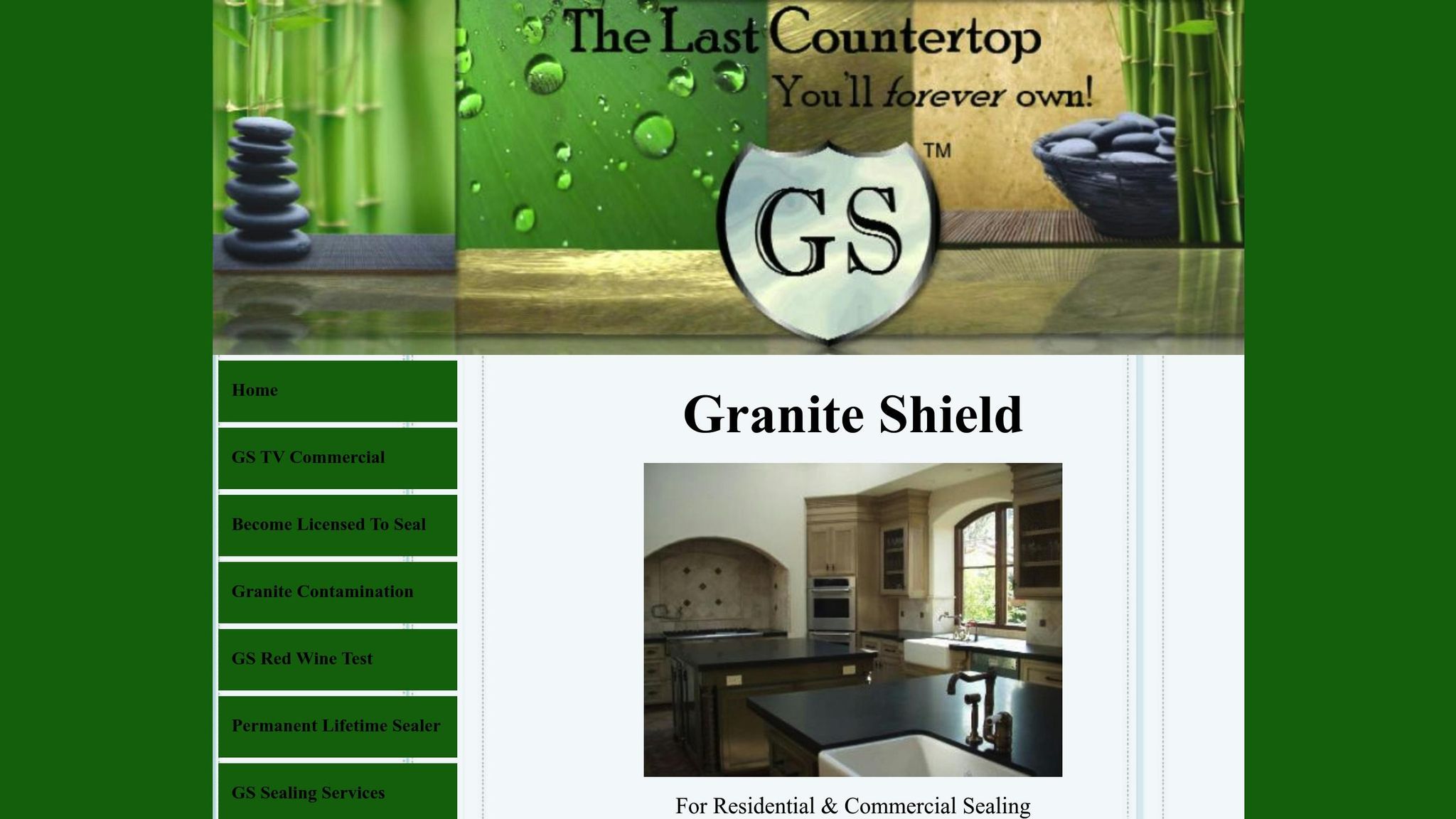
How to Choose the Right Sealant
Picking the right sealant begins with understanding the surface you’re working with. For concrete and masonry, penetrating silane/siloxane sealers are ideal. They maintain a natural, breathable finish, which is crucial for these types of materials. If you’re sealing natural stone, such as limestone or marble, go for neutral-cure silicones to prevent acid etching, which can cause permanent damage to these surfaces[2].
When dealing with moving joints – like where stainless steel countertops meet stone backsplashes – low-modulus silicone is your best bet. It accommodates the expansion and contraction of different materials. For applications involving rigid assemblies with minimal movement, high-modulus silicone is a better choice[2].
If you’re looking for a natural, matte finish that also provides slip resistance, penetrating sealers are the way to go, especially for high-traffic areas. On the other hand, film-forming acrylics and urethanes create a glossy, wet-look finish but can be slippery unless they include anti-slip additives[4].
Key Performance Features for Outdoor Use
For outdoor applications, performance is everything. UV resistance is critical to prevent issues like chalking and cracking, which can occur when a sealant loses elasticity over time[2]. Water repellence is another must-have, as it protects surfaces from moisture damage, while resistance to oil and grease stains is particularly useful in areas like kitchens. For example, neutral-cure silicones are excellent for kitchens since they resist many contaminants and won’t corrode metals or stain stone edges[2].
Another essential property is vapor permeability, especially for concrete and masonry surfaces. Breathable, penetrating sealers allow moisture vapor to escape, preventing problems like blistering or white hazing that can occur with non-breathable coatings. This is particularly important in humid climates like Maryland, where trapped moisture can lead to significant damage[3].
In regions with fluctuating winter temperatures, like the Mid-Atlantic, freeze–thaw durability is a top priority. "Window & Door" silicones are specifically formulated to handle seasonal movement and UV exposure while maintaining their adhesion in cold conditions[1]. For concrete and pavers exposed to de-icing salts, penetrating breathable sealers help reduce water absorption, lowering the risk of spalling caused by freeze–thaw cycles[3].
Environmental and Regulatory Considerations
Sealant selection should also take into account environmental factors and local regulations. Opt for low-VOC or CARB/OTC-compliant products to meet sustainability standards. Neutral-cure silicones are a great choice here – they emit less odor than acetoxy systems and reduce the risk of acid-related staining on natural stone surfaces[2].
Maintenance and Durability
How often a sealant needs maintenance depends on the type. Penetrating sealers typically require reapplication every 1–5 years, and a simple water-bead test can help you determine when it’s time to reseal. Meanwhile, film-forming acrylics may need more frequent renewal, especially in areas exposed to intense sunlight, as they are prone to wear and discoloration[3].
For long-lasting exterior performance, elastomeric silicones with excellent UV resistance and flexibility are the top choice. The key is to match the sealant’s properties with your specific surface, environmental exposure, and maintenance needs. This ensures the best results and extends the life of your project[3].
1. Ghostshield Siloxa-Tek 8500
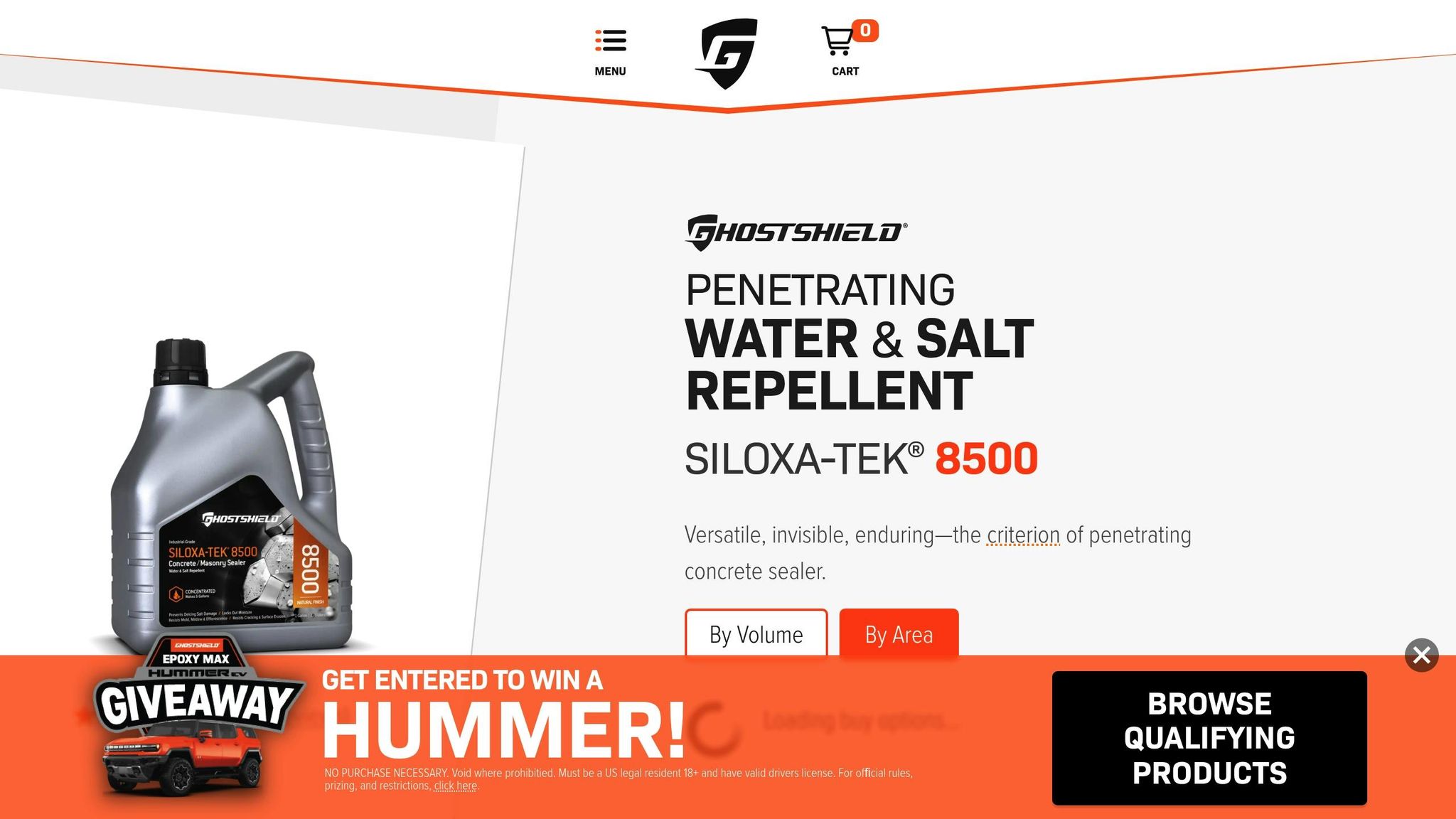
Ghostshield Siloxa-Tek 8500 is a reliable choice for protecting outdoor surfaces in Maryland’s fluctuating weather. This penetrating sealer, with its silane/siloxane formula, offers long-lasting protection while maintaining the natural appearance of the surface.
Substrate Compatibility
This product works exceptionally well on porous surfaces like concrete countertops, natural stone, and brick backsplashes – materials often found in outdoor kitchens. It penetrates deeply into the surface instead of forming a film, ensuring effective protection without altering the look. However, keep in mind that it’s most effective on unsealed, porous materials. Dense surfaces like granite or polished marble may not absorb the sealer as well, limiting its effectiveness.
Performance Features
One standout quality of Siloxa-Tek 8500 is its ability to repel water. By significantly reducing water absorption, it helps protect surfaces from damage while still allowing moisture vapor to escape. This feature prevents water from getting trapped, reducing the risk of issues like cracking or staining. Additionally, the sealer is designed to resist spills and endure prolonged exposure to UV rays.
Durability in Harsh Weather
Outdoor kitchens in climates with unpredictable weather – think freeze-thaw cycles and de-icing salts – can benefit greatly from this product. Its penetrating design helps minimize the chances of cracking, spalling, or other surface damage. Plus, it reduces the risk of unsightly haze or blistering that can occur with some sealers.
Application Tips
For best results, always follow the manufacturer’s instructions. Apply multiple thin coats to ensure the sealer penetrates thoroughly and provides maximum protection. Be sure to let the surface cure fully, as recommended, before exposing it to water or moisture. Proper application is key to achieving long-lasting results.
2. Foundation Armor Acrylic Sealer
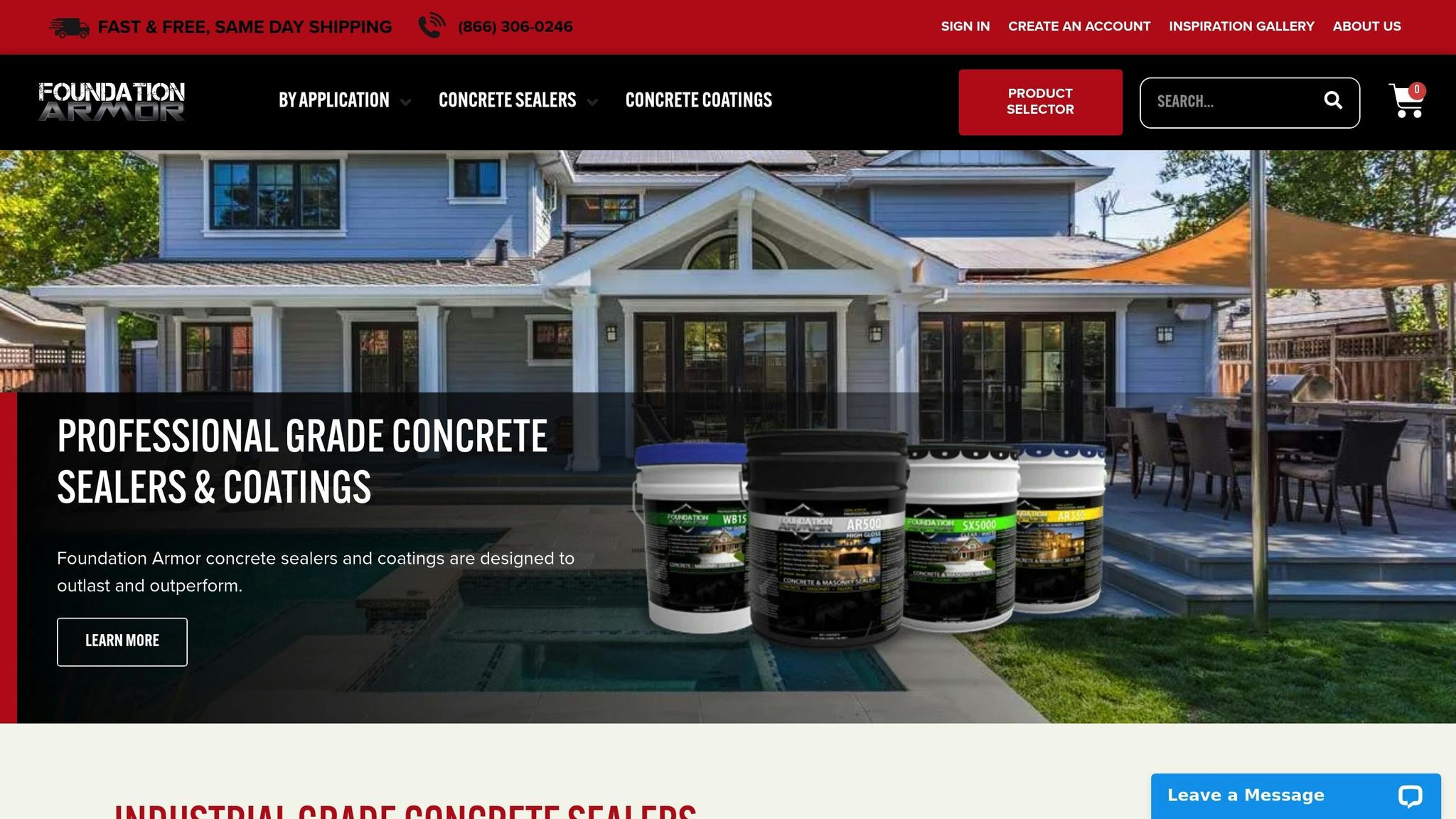
The Foundation Armor Acrylic Sealer is a cost-effective option for protecting outdoor surfaces. Its water-based acrylic formula not only safeguards but also enhances the natural color and texture of the material.
Substrate Compatibility
This sealer is versatile, working well on outdoor kitchen surfaces like concrete countertops, stamped concrete floors, and exposed aggregate areas. It’s particularly effective on textured and decorative concrete. Whether you’re applying it to a new surface or refreshing a previously sealed one, it bonds effectively. However, it’s not suitable for dense natural stones like marble or limestone.
Performance Factors
The acrylic formula provides strong water resistance, forming a protective barrier to reduce moisture penetration and minimize stains from cooking spills. While it offers moderate protection against cooking oils and stains, it doesn’t match the chemical resistance of some penetrating sealers. It also includes moderate UV protection to help slow surface wear, though you might notice some fading after 2-3 years of exposure to intense sunlight in outdoor settings.
Finish Type
This sealer dries to a low-gloss finish, which enhances the surface without making it overly shiny. It’s a great choice if you’re looking for a natural appearance in your outdoor kitchen. On textured surfaces, it delivers decent slip resistance, but smooth concrete could become a bit slippery when wet. For areas with heavy foot traffic, adding a non-slip additive during application is a smart move. Its balanced finish makes it a good option for outdoor spaces, especially when dealing with Maryland’s challenging weather conditions.
Climate Durability
Maryland’s unpredictable weather puts this sealer to the test. It holds up well against moderate freeze-thaw cycles but may show wear after particularly harsh winters. Its water-based formula helps minimize issues caused by humidity. However, it offers limited salt resistance, so if your outdoor kitchen is near a coastal area or exposed to de-icing salts, you’ll need to reapply more often – usually every 1-2 years instead of the typical 2-3 years.
3. TotalBoat Concrete Coating
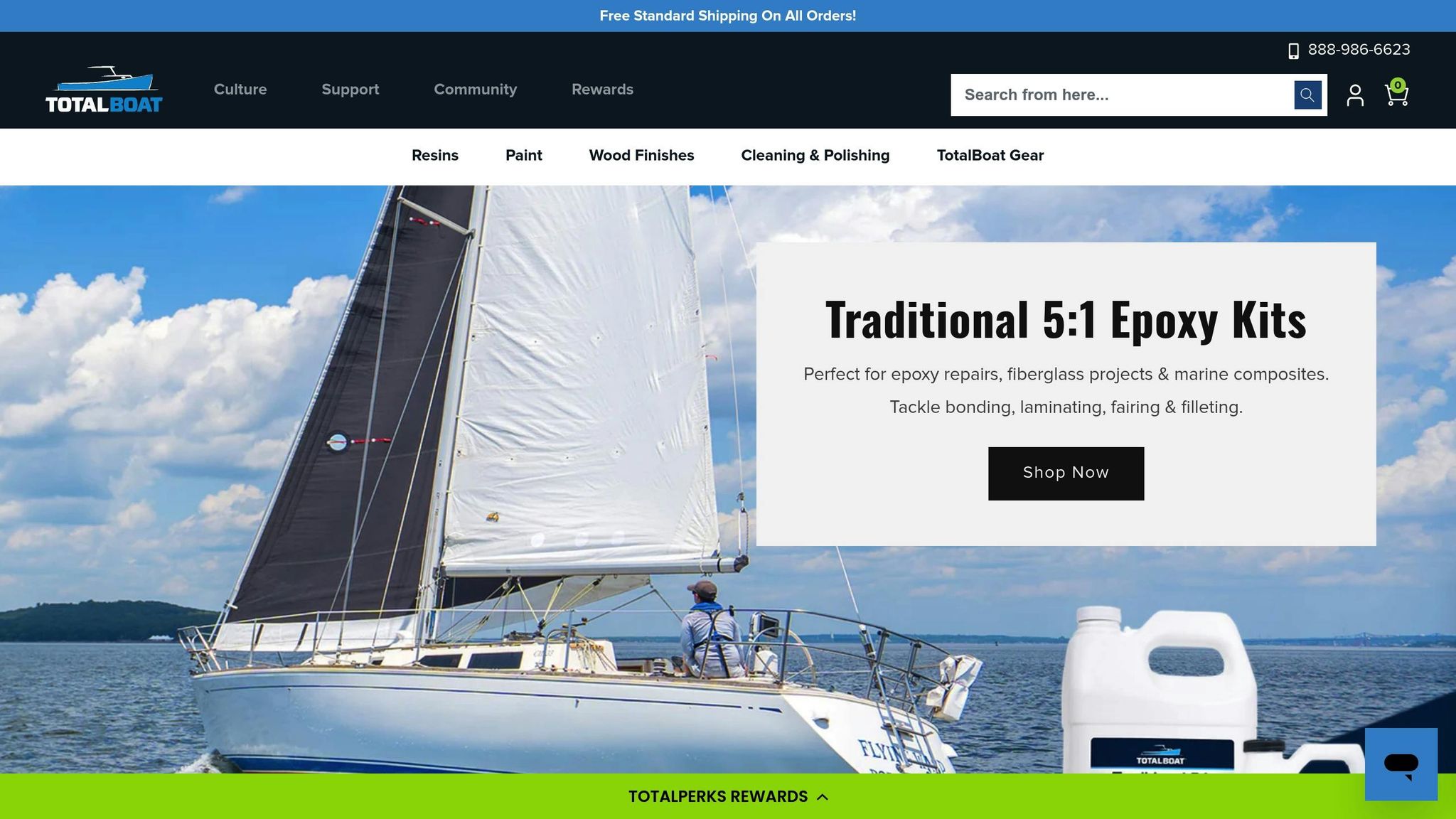
TotalBoat Concrete Coating is an epoxy-based sealant specifically crafted for concrete surfaces in outdoor kitchens. It provides a tough, long-lasting finish that enhances both the look and functionality of these areas.
Substrate Compatibility
This coating is ideal for concrete surfaces such as countertops, floors, and block walls. To achieve the best results, ensure the surfaces are clean, completely dry, and free of any previous coatings before application.
Application and Finish
Applying TotalBoat Concrete Coating is a simple process when following the manufacturer’s instructions. Once cured, it creates a sleek, high-gloss finish that adds a polished touch to outdoor kitchens. For areas like floors where slip resistance is a concern, consider adding a non-slip additive as outlined in the product guidelines.
Performance and Maintenance
The durability of this epoxy sealant relies on proper application and regular upkeep. For detailed information on its resistance to chemicals and water, as well as maintenance tips, refer to the product instructions. These features make it a reliable choice for outdoor kitchen surfaces exposed to the elements.
4. Black Diamond Stoneworks Stone Sealer
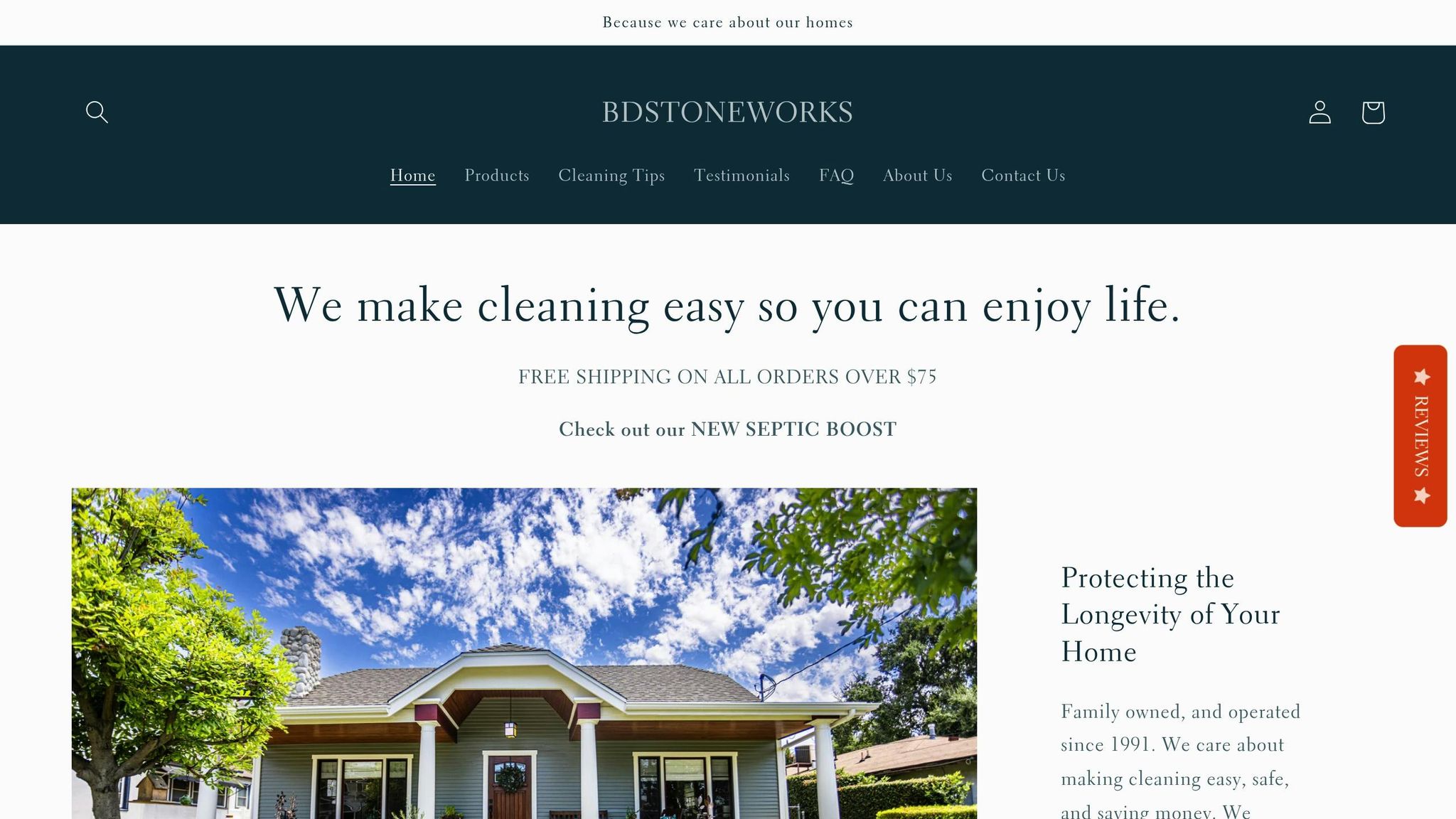
Black Diamond Stoneworks Stone Sealer is a water-based, penetrating solution designed to protect natural stone in outdoor kitchens. It forms an invisible shield that safeguards stone surfaces without changing their look or texture.
Substrate Compatibility
This sealer is ideal for porous natural stones often used in outdoor spaces, such as granite countertops, slate, limestone backsplashes, and travertine flooring. It also works well on concrete pavers and sandstone. Unlike surface coatings, this formula seeps deep into the stone, allowing it to "breathe" naturally.
For best results, make sure the stone is clean, dry, and unsealed before application. Always test the product on a small, less visible area first.
Performance Factors
The Black Diamond formula provides strong water resistance while allowing vapor to pass through, which is crucial for preventing moisture-related issues like cracking or discoloration. It also offers moderate oil resistance, making it suitable for outdoor kitchens where spills from cooking oils or food are common. However, acidic substances like lemon juice or vinegar should be cleaned up quickly to avoid damage, especially on sensitive stones like marble or limestone.
Another standout feature is its UV stability. This sealer won’t yellow or degrade under prolonged sun exposure, helping maintain the natural beauty of your stone even during long, sunny summers. These attributes make it well-suited to the challenges of Maryland’s seasonal weather.
Climate Durability
Black Diamond Stoneworks Stone Sealer is built to handle Maryland’s diverse climate. Its penetrating formula adapts to temperature changes, minimizing damage from freeze-thaw cycles during colder months.
The breathable nature of the sealer also ensures excellent humidity resistance, which helps prevent moisture buildup, efflorescence, and mold – especially valuable during Maryland’s humid summers when outdoor kitchens face both weather and cooking-related moisture.
Reapplication is typically needed every 2-3 years, depending on how much wear and tear the surface endures and the stone’s porosity. To check if it’s time to reseal, place a few drops of water on the stone. If the water absorbs instead of beading up, it’s time for a fresh coat.
5. Eco-Tuff Clear Coat Concrete Sealer
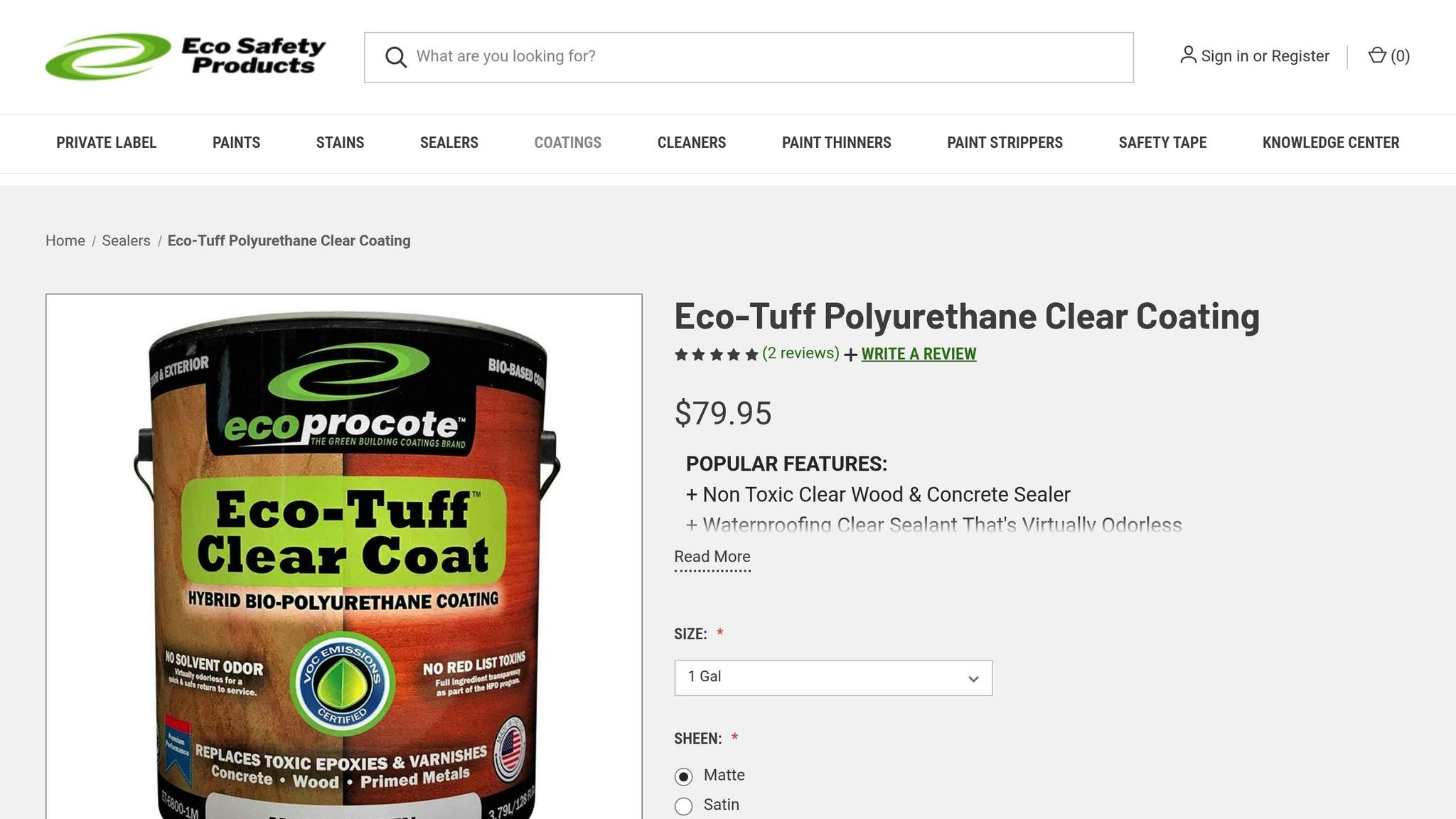
Eco-Tuff Clear Coat Concrete Sealer is an acrylic-based product designed to form a protective layer on outdoor kitchen concrete surfaces. This coating not only safeguards the concrete but also enhances its appearance, making it more resilient against weather and wear.
Substrate Compatibility
This sealer is ideal for concrete countertops, floors, and decorative surfaces commonly found in outdoor kitchens. It works particularly well on stamped, exposed, textured, or smooth concrete finishes. Additionally, it adheres effectively to previously sealed concrete, making it a great choice for maintenance projects.
Before applying, ensure the concrete has cured for at least 28 days. The surface must be clean, dry, and free of oils, waxes, or any coatings that could hinder adhesion. For optimal results, apply when the temperature is between 50°F and 90°F.
Proper preparation ensures the sealer delivers long-lasting protection.
Performance Factors
Eco-Tuff offers outstanding UV resistance, which helps prevent yellowing and keeps the surface clear even under intense sunlight.
The sealer creates a water-resistant barrier, minimizing moisture penetration and reducing the risk of freeze-thaw damage. While it provides moderate oil resistance, it’s best to clean up cooking oils and spills promptly to prevent staining.
Another key benefit is its chemical resistance to common outdoor kitchen substances, such as mild acids from food or cleaning products. However, avoid harsh degreasers or acid-based cleaners, as they can weaken the sealant’s protective layer.
Finish Type
The sealer dries to a semi-gloss finish that enhances the concrete’s natural color and texture. This finish strikes a balance – adding enough shine to highlight decorative features without making the surface overly slick.
When applied correctly, the product provides good slip resistance. For areas prone to frequent wetness, such as around sinks or prep stations, consider mixing in a slip-resistant additive during application to improve traction.
Climate Durability
Eco-Tuff is built to handle Maryland’s varied climate conditions. Its flexible acrylic formula adjusts to temperature changes, reducing the risk of cracking or peeling.
The sealer’s freeze-thaw resistance is especially valuable for outdoor kitchens exposed to harsh winters. Its flexibility helps protect against damage caused by freezing water in surface pores.
In humid summer months, the moisture barrier prevents efflorescence and limits mold or mildew growth on concrete. To maintain its performance, reapply the sealer every 3-4 years, depending on foot traffic and exposure. Routine cleaning with mild soap and water will help extend its lifespan.
6. Seal-Once Nano+Poly Premium Wood Sealer
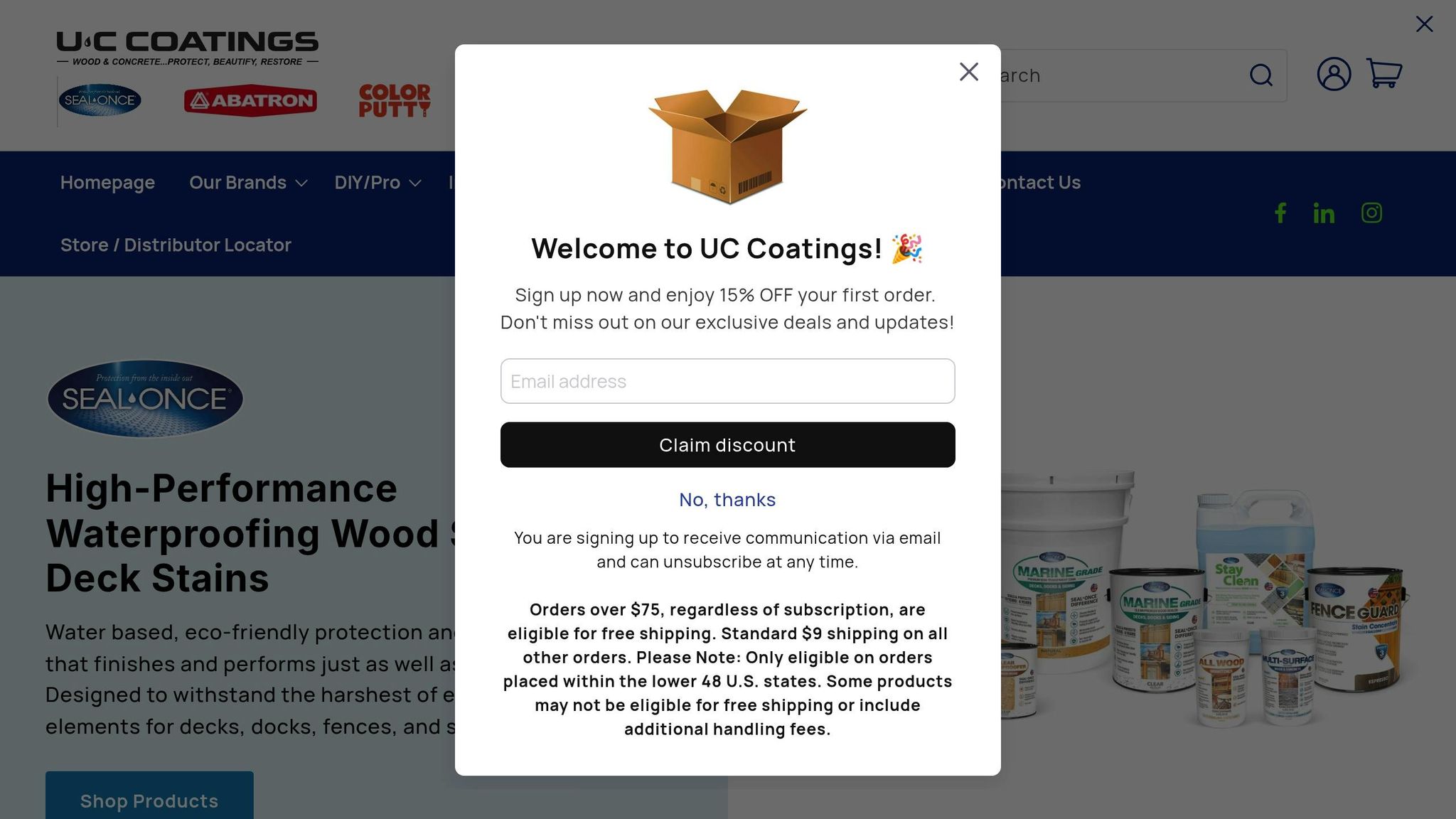
Seal-Once Nano+Poly Premium Wood Sealer combines the latest in nanotechnology with polyurethane to deliver tough, long-lasting protection for outdoor wood. It penetrates deep into the wood while adding a protective layer on the surface, making it a solid pick for outdoor kitchen elements that endure heat, moisture, and shifting weather.
Substrate Compatibility
This sealer works well on a variety of wood types, including cedar, redwood, pine, and pressure-treated lumber – materials commonly found in outdoor kitchen builds. It’s particularly effective on wood countertops, cabinet doors, pergola beams, and decorative trim around cooking areas.
It can be applied to both new and weathered wood. For new wood, wait at least 30 days post-installation to let the natural oils settle before sealing. Weathered wood should be cleaned thoroughly and allowed to dry for 24–48 hours prior to application.
For best results, apply the sealer when temperatures are between 50°F and 85°F and ensure the wood has a moisture content below 15%. One gallon covers approximately 150–200 square feet, making it well-suited for demanding environments like Maryland, where weather conditions can be unpredictable.
Performance Factors
The nanotechnology in this formula provides excellent UV protection, helping to guard against graying and weathering during the first season of exposure. Its dual-action design combines nano particles that fill the wood’s pores with a polyurethane barrier, reducing water absorption and minimizing risks like warping, cracking, or rot.
While its oil resistance is moderate, it’s effective for most outdoor kitchen needs. Cooking oils and food spills tend to bead up on the surface, making cleanup easier. However, prompt cleaning is recommended to avoid staining, especially on lighter wood tones.
The sealer also stands out for its resistance to mold and mildew – an essential feature for humid areas where moisture tends to collect around cooking spaces.
Finish Type
Seal-Once Nano+Poly dries to a natural, low-sheen finish that enhances the wood grain without masking its texture. This finish not only preserves the wood’s natural beauty but also provides a protective layer.
The treated surface offers solid slip resistance, making it a good choice for outdoor kitchen floors and steps. It also improves grip when wet, which is a notable advantage over untreated wood.
Additionally, this sealer is designed to resist peeling or flaking and doesn’t require stripping for reapplication, making it easier to maintain compared to traditional film-forming alternatives.
Climate Durability
This sealer is built to handle Maryland’s challenging climate. Its flexible formulation expands and contracts with temperature changes, preventing cracks, while its deep penetration reduces water infiltration during freeze-thaw cycles and humid summers.
In the summer months, the moisture barrier limits water absorption while allowing the wood to breathe. This vapor-permeable quality prevents moisture from getting trapped inside, reducing the risks of rot and decay.
For ongoing protection, reapply every 4–6 years on horizontal surfaces and every 6–8 years on vertical ones. Regular light cleaning can further extend its effectiveness, keeping your outdoor kitchen wood in top shape.
sbb-itb-843f8be
7. Seal-Once Marine Premium
Seal-Once Marine Premium is a high-performance wood sealer built to withstand tough outdoor conditions. Designed specifically for marine environments, it provides long-lasting protection for outdoor kitchen surfaces exposed to moisture and fluctuating weather.
Substrate Compatibility
This sealer works effectively on a variety of wood types, making it a versatile choice for outdoor kitchens. It’s ideal for premium hardwoods like teak and ipe, as well as softwoods such as cedar and redwood. For the best results, apply it to clean, dry wood. If the wood is weathered, lightly sanding the surface can help improve adhesion.
Performance Factors
Seal-Once Marine Premium is formulated to resist UV rays, water damage, and oil stains, helping to preserve the wood’s natural appearance. It creates a protective barrier that enhances durability and keeps the wood looking its best over time.
Finish Type
Once applied, this sealer dries to a satin finish, subtly highlighting the wood’s natural grain with a gentle sheen. As a penetrating sealer, it doesn’t form a surface film, which means there’s no risk of peeling or chipping. Even better, it maintains slip resistance, even when the surface is wet – an important feature for outdoor kitchens.
Climate Durability
Built to handle a range of environmental conditions, Seal-Once Marine Premium is a dependable option for outdoor spaces that experience temperature shifts and moisture exposure. Its strong formulation ensures lasting protection, making it well-suited for areas with unpredictable weather, like Maryland.
8. Thompson’s WaterSeal Clear Multisurface/Transparent
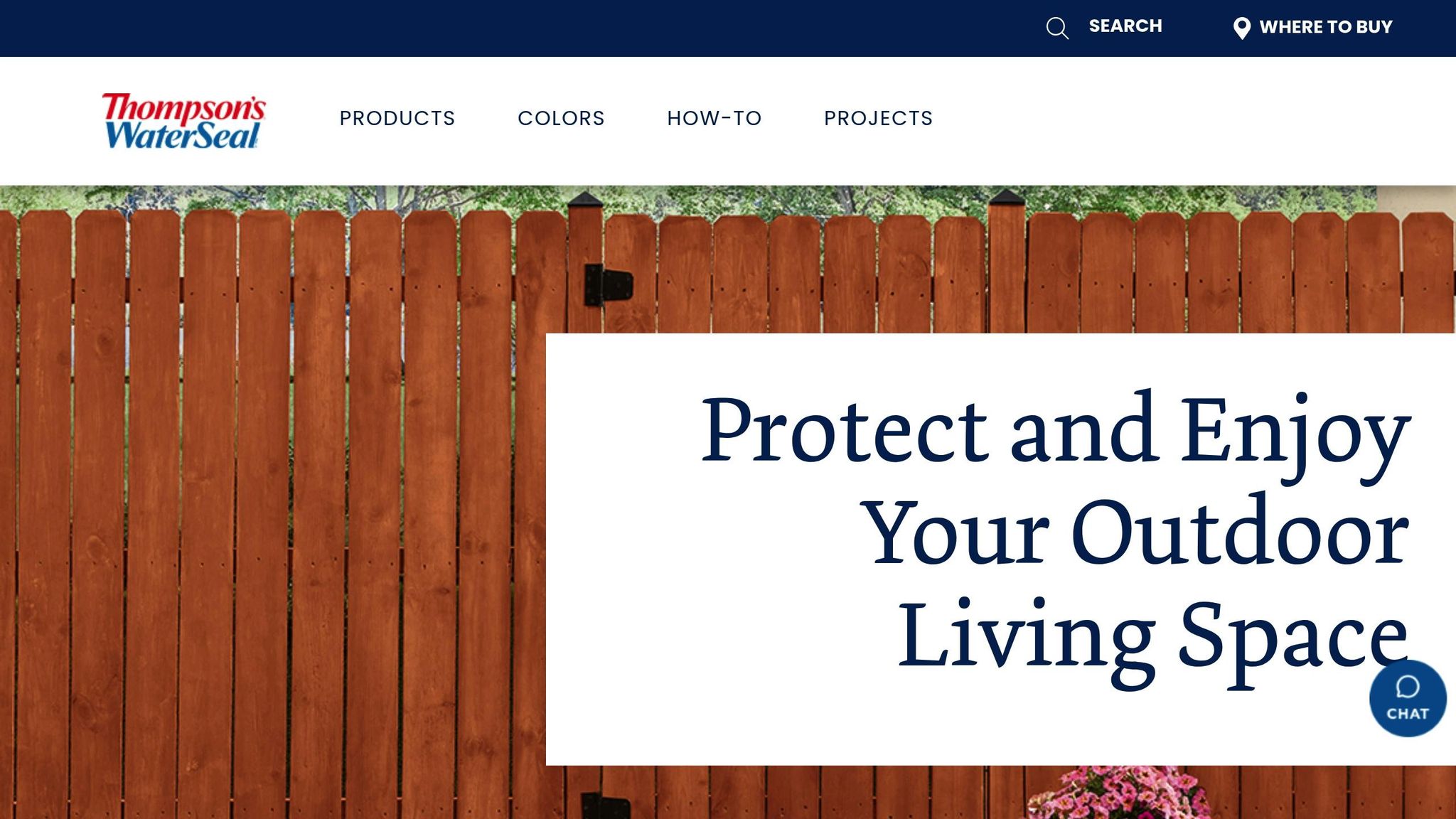
Thompson’s WaterSeal Clear Multisurface is a dependable option for protecting a variety of outdoor kitchen surfaces. Its transparent formula safeguards against water damage while keeping the original look of your materials intact.
Substrate Compatibility
One of the key strengths of this sealer is its versatility. It adheres well to a range of surfaces, including concrete countertops, natural stones like granite and slate, brick, and various wood types such as cedar and pressure-treated lumber. It’s especially effective on porous materials where water seepage can be a problem. For best results, make sure the surface is clean and dry, and remove any old sealants before applying. This preparation ensures the sealer bonds effectively, providing lasting protection.
Performance Factors
Thompson’s WaterSeal penetrates deeply to create a strong barrier against moisture. It also offers some resistance to light oil spills, helping to prevent stains. Beyond water protection, it reduces the risk of mold and mildew on outdoor surfaces. While it does provide basic UV protection, it’s not as strong as specialized UV-blocking sealers, so wood surfaces may experience some fading over time.
Finish Type
This sealer dries clear, allowing the natural color and texture of your surfaces to shine through. Unlike film-forming sealers that create a glossy layer prone to chipping or peeling, Thompson’s WaterSeal penetrates the material, leaving a low-sheen finish. This not only preserves the natural look but also maintains decent slip resistance – though wet stone or concrete can still be slippery. Its understated finish makes it a practical choice for outdoor spaces, balancing aesthetics with durability.
Climate Durability
Thompson’s WaterSeal holds up well in humid conditions, such as those found during Maryland’s summers, helping to prevent moisture-related damage. It also performs adequately through freeze-thaw cycles and offers basic resistance to salt exposure. However, in harsher climates, reapplication may be needed every 1-3 years to maintain its protective qualities.
9. Loctite Clear Silicone or Gorilla Waterproof Caulk & Seal
Silicone caulks like Loctite Clear Silicone and Gorilla Waterproof Caulk & Seal are specifically designed to seal joints, gaps, and connections where different materials meet – places that traditional surface sealers can’t effectively protect.
Substrate Compatibility
Both Loctite and Gorilla silicone caulks adhere well to a wide range of outdoor kitchen materials, including stainless steel appliances, concrete countertops, natural stone, ceramic tiles, and various metals. They’re particularly effective in areas like sink installations, where countertops meet plumbing fixtures, or along backsplash edges where tile meets stone or concrete. Their flexibility allows them to handle the natural expansion and contraction that happens with temperature changes in outdoor environments.
To ensure proper adhesion, clean the surfaces with rubbing alcohol, dry them thoroughly, and remove any old caulk. This preparation helps these products deliver strong moisture and oil resistance.
Performance Factors
These silicone-based caulks offer excellent water resistance, creating a watertight seal that keeps moisture from seeping into joints and causing hidden damage. They also resist common cooking oils and grease, making them a practical choice for food prep areas where spills are frequent. However, their UV resistance is moderate – clear formulas may yellow slightly over a period of 3-4 years.
Their chemical resistance makes them compatible with typical outdoor kitchen cleaning products, including bleach-based cleaners and degreasers. This durability ensures they hold up well in high-maintenance areas that require frequent sanitizing.
Finish Type
Both caulks dry to a clear, low-gloss finish that stays flexible instead of hardening like traditional sealers. This flexibility is essential for outdoor use, as materials expand and contract with temperature changes. The clear finish blends seamlessly with most surfaces, though it may collect dirt over time in busy areas.
Since these products are designed for filling gaps rather than coating surfaces, slip resistance isn’t a concern. However, they create smooth transitions that help prevent debris buildup and make cleaning easier.
Climate Durability
Silicone caulks are highly reliable in freeze-thaw conditions, maintaining their flexibility and seal strength even when temperatures dip below 0°F. This makes them an excellent choice for regions like Maryland, where winters can be unpredictable. They also perform well in humid environments, resisting degradation and avoiding mold growth, which can be an issue with some organic sealers.
Even salt exposure, whether from winter road treatments or coastal air, doesn’t significantly impact their performance. To keep the seal intact, it’s recommended to recaulk joints every 5-7 years. While this periodic maintenance is necessary, the durability and performance make these caulks a cost-effective option for protecting outdoor kitchens over the long term.
10. Defy Composite Deck Sealer
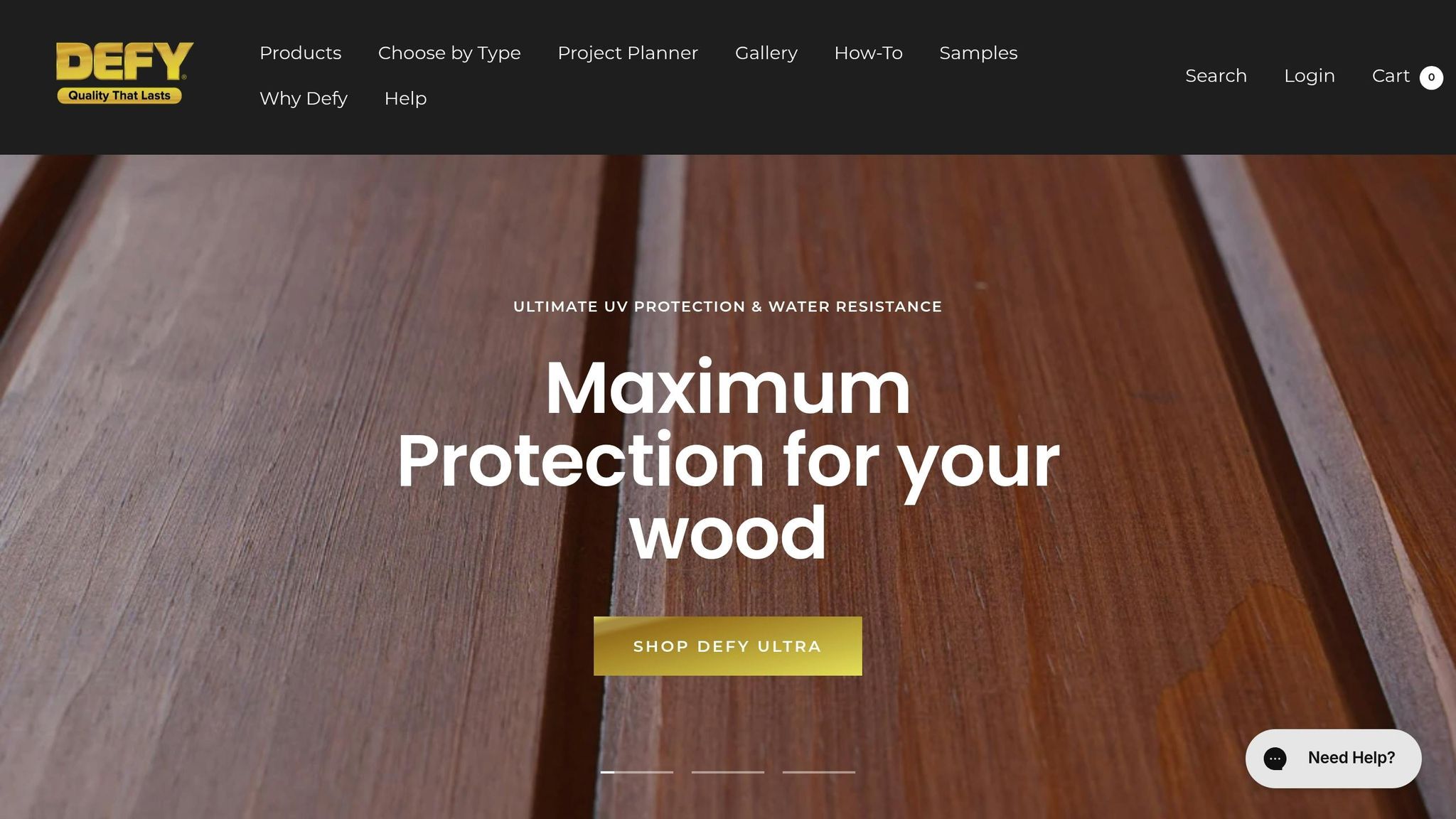
Maryland’s unpredictable weather can be tough on outdoor surfaces, but Defy Composite Deck Sealer is designed to handle the challenge. It offers reliable protection for composite decking, making it a great choice for outdoor kitchens.
Substrate Compatibility
This sealer is tailored for composite decks but works equally well on natural wood surfaces. However, it’s not suitable for brand-new, non-porous composite lumber. For the best results, let the surface weather naturally until it becomes absorbent. Before application, make sure the area is clean, dry, and porous. Any painted or varnished sections should be removed. With the right preparation, this sealer delivers excellent performance.
Performance Highlights
Defy Composite Deck Sealer is packed with advanced UV protection. Its formula contains over 30 trillion zinc nano-particles per square inch, which help reflect harmful UV rays and prevent black algae stains[5][6]. These features make it particularly effective against Maryland’s intense sunlight and moisture conditions.
At $58.83 per gallon[5][6], it’s an affordable and efficient option for keeping your outdoor kitchen looking its best.
Sealant Comparison Chart
Choosing the right sealant for your outdoor kitchen in Maryland can be a challenge, especially with the state’s varied climate. Below, you’ll find a quick overview of sealants, highlighting their primary features and uses to help you make the best decision.
- Ghostshield Siloxa-Tek 8500: A penetrating sealer designed for concrete and masonry surfaces.
- Foundation Armor Acrylic Sealer: A water-based acrylic option suitable for concrete and pavers.
- TotalBoat Concrete Coating: An epoxy-based coating ideal for concrete surfaces.
- Black Diamond Stoneworks Stone Sealer: Provides penetrating protection for natural stone materials.
- Eco-Tuff Clear Coat Concrete Sealer: A clear acrylic sealer for both concrete and stone surfaces.
- Seal-Once Nano+Poly Premium Wood Sealer: Features a nanotechnology formula tailored for wood surfaces.
- Seal-Once Marine Premium: Offers marine-grade protection specifically for hardwoods.
- Thompson’s WaterSeal Clear Multisurface (Transparent): A transparent sealer suitable for multiple surface types.
- Loctite Clear Silicone or Gorilla Waterproof Caulk & Seal: Flexible options for sealing joints and gaps.
- Defy Composite Deck Sealer: A specialized formula for composite and wood decking.
When selecting a sealant, keep the following points in mind:
- Surface Compatibility: Ensure the sealant matches the material you’re working with.
- Climate Suitability: Opt for formulations that can handle Maryland’s weather conditions.
- Maintenance and Durability: Check the manufacturer’s recommendations for upkeep and reapplication, and balance cost with how long the sealant will last.
Use this guide to compare options and select the product that aligns with your needs for a durable and well-protected outdoor kitchen.
How to Apply and Maintain Sealants
Maryland’s tough weather can take a toll on outdoor kitchens, making proper sealant application a must for durability. When applied and maintained correctly, sealants create a strong protective barrier that extends the life of your outdoor kitchen. Success in sealing comes down to careful preparation, proper application, and consistent maintenance.
Surface Preparation: The Foundation of Success
Getting the surface ready is the most important step in the sealing process. Gary Byrum, CRL Product Manager and Sealant Specialist, puts it best:
"The key to good sealant adhesion is a clean surface" [10].
Different materials need different preparation methods. Here’s how to get started:
- Remove Old Sealant: Use a utility knife or a specialized remover to strip away any old sealant. This ensures the new sealant bonds directly to the surface, not to degraded material.
- Clean Thoroughly: Dirt, grease, and oils can stop sealants from sticking. For non-porous surfaces, use a 50-70% isopropyl alcohol mix and a two-cloth cleaning method. Porous materials like concrete, granite, or natural stone may need more intensive cleaning – dusting, grinding, sandblasting, or solvent cleaning can help remove laitance, dirt, and old residues [10].
- Inspect and Repair: Check for cracks, chips, or rough spots. Fix minor cracks in concrete and sand wood surfaces for smoothness. Ensure the surface is completely dry before applying the sealant – moisture can lead to peeling, mold, or other issues. Depending on the weather, allow 24 to 48 hours for drying.
What to Avoid During Cleaning
Using the wrong cleaning products can harm your surfaces or compromise the sealant’s adhesion. For example:
- Concrete Countertops: Avoid ammonia, vinegar, lemon juice, and acid-based cleaners, as these can damage the sealant and stain the concrete [8].
- Granite Countertops: Stay away from abrasive pads, acidic cleaners (like vinegar or citrus juice), ammonia-based products, and bleach. Instead, use soft cloths or microfiber materials for cleaning [9].
Application Techniques and Timing
Sealants perform best when applied under the right conditions – ideally between 50°F and 85°F. Avoid applying during high humidity or when rain is expected during the curing period. Since coverage rates depend on the product and surface porosity, always check the manufacturer’s guidelines to calculate how much you’ll need.
For the best results:
- Apply several thin coats rather than one thick layer. This allows for better penetration and durability.
- Let each coat cure fully before applying the next or exposing the surface to moisture or use.
Maintenance Schedules and Techniques
Routine upkeep can significantly extend the life of sealed surfaces. Most outdoor kitchen sealants need reapplication every 1 to 3 years. Between applications, clean surfaces with a pH-neutral cleaner and warm water. Avoid harsh chemicals or acidic agents, which can strip the sealant or cause etching [7].
Even with a sealant, spills should be cleaned up quickly. Sealants protect surfaces, but they aren’t completely impermeable. Watch for signs that reapplication may be needed, such as water soaking in instead of beading, visible wear, or darker areas when the surface is wet.
Following Manufacturer Instructions
Every sealant is different, with specific requirements for preparation, application, and maintenance. Temperature ranges, humidity limits, cure times, and coverage rates can vary widely. Even the best sealant won’t work if the surface isn’t prepared correctly. Skipping steps or rushing can lead to poor adhesion, peeling edges, and gaps where water can seep in.
Always read and follow the manufacturer’s instructions carefully, including any safety guidelines. If you’re unsure about anything, don’t hesitate to reach out to their technical support.
For professional help with applying and maintaining sealants on outdoor kitchen surfaces, check out Pro Landscapes MD. Their expertise in outdoor kitchen design and hardscaping ensures a durable and polished finish. With proper application and regular upkeep, your outdoor kitchen will stay protected, even in Maryland’s challenging climate.
Maryland Climate Factors for Outdoor Kitchens
Maryland’s climate presents unique challenges for maintaining outdoor kitchens, especially when it comes to protecting surfaces with the right sealants. The state’s weather conditions – ranging from freezing winters to humid summers – can take a toll on outdoor materials if not properly sealed.
Freeze-Thaw Cycles: A Key Concern
In central Maryland, winters bring an average of 40 to 60 freeze-thaw cycles. With temperatures hovering around freezing, materials like concrete, natural stone, and grout are subjected to constant expansion and contraction. When water seeps into unsealed surfaces and freezes, it expands, causing cracks and surface spalling over time. This cycle is a primary reason for wear and tear on outdoor kitchen surfaces.
Humidity and Moisture Issues
Maryland summers are notoriously humid, with levels often exceeding 60%. This high moisture content can encourage mold and mildew growth and lead to efflorescence – those white, powdery deposits on surfaces. Humidity, combined with temperature swings, can also weaken surface coatings. Sealants like Black Diamond Stoneworks Stone Sealer, which allow moisture vapor to escape while blocking liquid water, are excellent for preventing peeling, bubbling, and other moisture-related damage.
Sunlight and UV Damage
Maryland gets plenty of sunshine – between 2,800 and 3,200 hours annually. While great for outdoor gatherings, this sunlight can degrade polymers in sealants, leading to yellowing and cracks in as little as 12 to 18 months. For areas exposed to intense UV rays, products like TotalBoat Concrete Coating or Eco-Tuff Clear Coat Concrete Sealer, which include UV inhibitors, can help extend the life of your outdoor surfaces.
Deicing Salt Risks
Winter brings another challenge: deicing salts. Commonly used on roads, driveways, and walkways, salts like sodium chloride and calcium chloride can be carried by wind or runoff to your outdoor kitchen. These salts are highly corrosive and can cause pitting, spalling, and discoloration on concrete and stone. Using chemical-resistant sealers can provide much-needed protection against these effects.
Cooking Area Stains
Cooking areas in outdoor kitchens face exposure to oils, grease, and food stains. For these spaces, it’s crucial to use an oil-repellent sealant designed specifically for food preparation zones. These sealants make cleaning easier and prevent stains from setting in.
Timing Sealant Applications
Maryland’s climate dictates specific windows for applying sealants effectively. Spring (mid-April to May) and early fall (September through mid-October) are ideal times, as temperatures during these periods typically stay above 50°F. Summer applications can be tricky due to high humidity and frequent thunderstorms, while winter is generally unsuitable because of cold temperatures and excess moisture. Proper timing ensures better performance and durability of the sealant.
Why Professional Installation Helps
Considering these challenges, professional installation can make a big difference. Companies like Pro Landscapes MD understand Maryland’s climate and can recommend sealants tailored to the region. Their expertise in surface preparation, product selection, and application timing ensures your outdoor kitchen is ready to withstand everything from Annapolis’s coastal moisture to Mount Airy’s temperature swings.
From freeze-thaw cycles to UV exposure and salt contamination, Maryland’s climate demands careful planning when it comes to outdoor kitchens. Choosing the right sealants, applying them at the right time, and committing to regular upkeep are essential for keeping these spaces in top shape.
Conclusion
Selecting the right sealant comes down to understanding your surface type, the local climate, and the level of protection you’re aiming for – whether it’s sealing concrete with Ghostshield Siloxa-Tek 8500 or safeguarding composite decking with Defy Composite Deck Sealer.
In Maryland, the combination of freeze-thaw cycles, high humidity, and strong UV exposure can wreak havoc on unprotected surfaces. That’s why proper preparation and timely application are essential to ensure the sealant adheres well and lasts as long as possible.
Navigating these challenges often requires expert insight. In central Maryland, Pro Landscapes MD brings local expertise and proven preparation techniques to the table, helping to protect your outdoor spaces while maintaining their aesthetic appeal.
FAQs
What’s the best way to choose the right sealant for my outdoor kitchen surfaces?
Choosing the right sealant for your outdoor kitchen starts with understanding the material you’re working with and its specific requirements. For surfaces like granite or concrete, which are porous, penetrating sealers are a solid choice. They help protect against water damage and stains. Products such as Aqua Mix Sealer’s Choice Gold or Omega Concrete Sealer are excellent options for these types of materials. On the other hand, for denser stones like quartzite, impregnating sealers – like Stain Proof Dense Stone Impregnating Sealer – are more suitable.
To check if your sealant is still doing its job, try the water bead test. If water no longer beads up and instead soaks into the surface quickly, it’s time to reseal. When selecting a sealant, make sure it offers heat resistance, waterproofing, and chemical durability to handle outdoor conditions and keep your outdoor kitchen in top shape.
What environmental factors in Maryland should I consider when selecting a sealant for my outdoor kitchen?
When selecting a sealant for your outdoor kitchen in Maryland, you’ll need to account for the region’s frequent rain, high humidity, and intense sunlight. These environmental conditions demand a sealant with strong weather resistance and UV protection to guard against cracking, fading, or peeling over time.
Maryland’s temperature swings – cold winters and hot summers – add another challenge. These shifts cause surfaces to expand and contract, so a flexible and durable sealant is key to ensuring it holds up over the years. Also, consider products that are low in toxicity and safe for the environment. Some sealants, like those made with coal tar, are restricted in parts of Maryland due to environmental laws.
By choosing the right sealant, you’ll keep your outdoor kitchen protected and looking great for years to come.
How often should I reseal my outdoor kitchen surfaces to keep them protected?
To keep your outdoor kitchen surfaces in top shape, it’s a good idea to reseal them every 1 to 3 years. The exact timing depends on the material and how often the area is used. Surfaces that see heavy use or are exposed to the elements more often might need resealing sooner.
Simple upkeep, like routine cleaning and checking for signs of wear, can make a big difference. These steps not only help the sealant last longer but also keep your outdoor kitchen looking great.


















Chat with Us